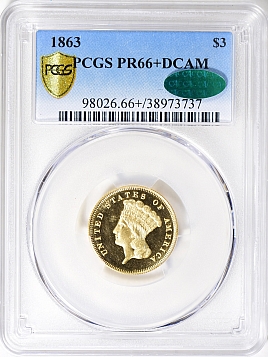
GreatCollections on CoinWeek ….
On Sunday, April 19, bidding ends on GreatCollections.com for this Proof 1863 Three-Dollar Gold Piece graded PR-66+ and certified Deep Cameo by PCGS and approved by CAC. It is the single-finest known example of the Proof issue.
 Only 39 Proof 1863 Three Dollar Gold pieces were produced at Philadelphia, and of that reported number only about 10 to 15 specimens are estimated to have survived to the present day. PCGS lists four of those Proofs as DCAM (Deep Cameo): two at PR-65, one at 66, and the current example at 66+.
Only 39 Proof 1863 Three Dollar Gold pieces were produced at Philadelphia, and of that reported number only about 10 to 15 specimens are estimated to have survived to the present day. PCGS lists four of those Proofs as DCAM (Deep Cameo): two at PR-65, one at 66, and the current example at 66+.
There is no auction history given for the PR-66+ DCAM, nor is there one for the 66 DCAM. But already this year a PR-65 DCAM specimen sold in January for $93,000 USD. The next-most-recent listing for a PCGS PR-65 goes back to September 2007(!) when an example sold for $87,400.
And lest one forget, the current coin is also deemed strong for its grade by CAC. At the time of writing, the high bid for this PCGS/CAC PR-66+ DCAM 1863 $3 gold is $92,500 after 52 bids.
If you want to check out GreatCollections for more information about prior sales, be sure to check out the GreatCollections Auction Archives, with records for over 600,000 certified coins the company has sold over the past seven years.
The Three Dollar Gold Coin on GreatCollections
The origin of the Three Dollar gold coin is shrouded in controversy. It is generally believed that the Three Dollar gold piece was adopted as a direct result of the postal rate dropping from five cents to three cents in 1851. A three dollar gold issue allowed purchasers to buy large quantities of the new stamps without having to use the then-unpopular copper large cents or the new, tiny silver Three Cent pieces.
The Mint Act of February 21, 1853 authorized production of the Three Dollar Gold. It did find use in circulation until about the early 1860s, when it suddenly stopped circulating. Responding to this drop in demand, the United States Mint reduced mintages for most of the remaining years of the issue’s run.
Three Dollar Gold pieces were struck at four mints: Philadelphia, San Francisco, New Orleans, and Dahlonega. There are two boldly different reverse types: the small DOLLARS appearing only in 1854 and the large DOLLARS appearing 1855-89. Many dates show bold “outlining” of letters and devices, resembling a double strike but probably the result of excessive forcing of the design punches into the die steel, causing a hint of their sloping “shoulders” to appear as part of the coin’s design. The high points of the obverse design that first show wear are the cheek and hair above the eye; on the reverse, check the bow knot and leaves.
This was not a popular denomination when it was struck and mintages were, for the most part, extremely limited. Only one date, the 1854, had a mintage figure greater than 100,000 and only four more exceeded 25,000. There are seven issues that had original mintages of fewer than 1,000.
Even fewer Proofs were struck, with the majority of dates not only having mintages of less than 100 but with most Proof issues having mintages of around 25 to 30.
A total of just over 535,000 pieces were issued, along with 2,058 proofs. The first coins struck were the 15 proofs of 1854. Regular coinage began on May 1, and that first year saw 138,618 pieces struck at Philadelphia (no mintmark), 1,120 at Dahlonega (D), and 24,000 at New Orleans (O). These two branch mints would strike coins only in 1854. San Francisco produced the three-dollar denomination in 1855, 1856, and 1857, again in 1860, and apparently one final piece in 1870. Mintmarks are found below the wreath.
Design
Obverse
The Three dollar gold piece was designed by James B. Longacre. The obverse features an “Indian Princess” modeled after the Greco-Roman Venus Accroupie statue then in a Philadelphia museum. Liberty is wearing a feathered headdress of equal-sized plumes with a band bearing LIBERTY in raised letters. She is surrounded by the inscription UNITED STATES OF AMERICA. Such a headdress dates back to the earliest known drawings of American Indians by French artist Jacques le Moyne du Morgue’s sketches of the Florida Timucua tribe who lived near the tragic French colony of Fort Caroline in 1562. It was accepted by engravers and medalists of the day as a kind of design shorthand for “America”.
Reverse
The reverse depicts a wreath of tobacco, wheat, corn and cotton with a plant at top bearing two conical seed masses. The original wax models of this wreath still exist on brass discs in a Midwestern collection. The denomination 3 DOLLARS in the center of the wreath, with the date 1863 beneath it.
Edge
The edge of the 1863 Three Dollar gold Proof is reeded.




